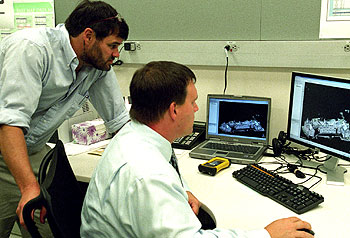Location is essential not only in real estate but also in Geospatial Information Systems (GIS).
GIS is a computational research tool that allows a user to plot or map space and data simultaneously and is used in diverse research fields from medicine, biology and geology to political science, history, education and anthropology.

A WUSTL initiative is bringing GIS technology to students, faculty and staff and is responsible for offering the first formal introductory and follow-up GIS courses open to any major on campus.
T.R. Kidder, Ph.D., professor of anthropology in Arts & Sciences, co-chairs the GIS Advisory Committee along with Dennis Martin, associate vice chancellor and associate dean of Arts & Sciences. Aaron Addison of WUSTL’s Network Technology Services is the University-wide GIS coordinator. Kidder and Martin work with an interdisciplinary committee, comprising 11 members.
GIS provides the mechanism to combine disparate pieces of information in a common arena so that they can be used in conjunction for analysis. A classic medical example is plotting the distribution of a disease — lung cancer — over a region atop a demographic pattern, such as race or gender.
On a different level, voting patterns in a county can be derived in a similar way.
According to Kidder, the GIS committee is supervisory and deals with educational and infrastructure details of making GIS available to the WUSTL community.
GIS has been the domain of geography and geology departments across the United States, but because the University has neither, acquiring GIS skills has been possible mainly through the exposure of students to the technology in various classes. Numerous faculty, for instance, use GIS routinely in earth and planetary sciences, anthropology and engineering, among other departments and schools.
“One way of thinking of it is as a fancy way of mapping, but it’s a lot more than that,” Kidder said. “You’re also able to organize your data, reorganize it and use the technology to ask questions or make predictions.”
Addison said that it is hard to imagine any research area that cannot leverage GIS to benefit research.
“Any phenomenon with a spatial relationship can be analyzed with GIS,” Addison said. “The power of GIS is tying the non-graphic with the graphic. It boils down to the philosophy that location is important.”
Kidder and Addison said that American consumers already are touched by GIS daily. Fire and police departments, municipal sewer districts, FedEx, UPS and many others have information stored in GIS form. The bar code on packages for delivery, for instance, has information about street locale, address and which driver will get the delivery.
Kidder said there are four components to the University’s GIS initiative: educational opportunities; building the technological infrastructure; developing and expanding GIS as a research tool on campus; and working with a broader community outside of the University.
“St. Louis is a very significant engine driving GIS locally,” Kidder said. “We have defense contractors, state and federal government agencies, educational institutions and corporations that are all consumers of GIS. We’d like to position the University as an ally and innovator. We think that we can help train a generation in the workforce that will go out there and use this technology for a wide variety of things.”
He said that this fall the University is offering Anthropology 373-573 “Introduction to GIS for Anthropologists” for the first time. Although the title suggests a specialized course, Anthropology 373 actually is a broad introduction to using GIS for research applications. In the spring semester, students can take Anthropology 4803: “Geographic Information Systems, Landscape and Spatial Analysis in Archaeology.” The courses are open to all majors.
University College in Arts & Sciences also offers Introduction to GIS, available for the third straight semester and taught this fall by Addison.
According to Addison, WUSTL has a site license for a product named ArcGIS by a ESRI, a vendor of GIS software. The site license offers access to an entire suite of software. Anyone can get access to it by going to the WUSTL GIS page (gis.wustl.edu) or by contacting software licensing in Network Technology Services. The site license is made available by funding from WUSTL Network Technology Services. “Two years ago, between 30 and 40 people had a license, and today more than 400 do,” Addison said.
Kidder said knowing how to use GIS should become part of a “rounded” person’s work skills, as important and essential as speaking, writing and cooperating with fellow workers.
“GIS is a 21st-century technology, and our students, faculty and staff ought to have the benefits that GIS brings,” Kidder said. “It will become increasingly common in the workplace, and we are, in part, in the business of preparing people for the workplace. GIS is one good part of the arsenal of job skills.”